Articles on Animation &Rowland B. Wilson 02 Dec 2008 09:10 am
Rowland Wilson
- Rowland Wilson was one of those artists/cartoonists who was loved by everyone.
Long before I saw his connection to animation, I knew his amazing cartoons in Playboy. They were full page color images that were gorgeous to look at, and it was irrelevant whether they were funny or not. They were beautiful.
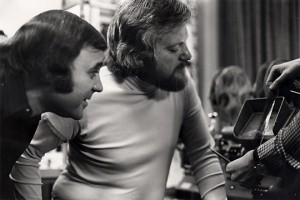 I met him only once on the School House Rock pieces he designed for Phil Kimmelman‘s PK&A back in 1973. I was an Asst. Animator there working on the spots that were animated by Jack Schnerk, Sal Faillace or Dante Barbetta. My meeting was little more than a hello.
I met him only once on the School House Rock pieces he designed for Phil Kimmelman‘s PK&A back in 1973. I was an Asst. Animator there working on the spots that were animated by Jack Schnerk, Sal Faillace or Dante Barbetta. My meeting was little more than a hello.
I knew Rowland’s daughter, Amanda, who worked on Raggedy Ann, opaquing. We kept in touch for a short while after the film’s
_..__ Phil Kimmelman and Rowland Wilson__________completion. She continued in the NY
__________________________.__________________animation community for a while, until work dried up. Unfortunately, I’ve lost track of her.
Of course, it would have been Richard Williams that put him to work seriously in animation. Together they created the stunning ads for Count Pushkin Vodka. This was the
high water mark of his and Williams’
ad films. I think this ad campaign was one of the high water marks for advertising, in general. The Wilson and Williams’ work is extraordinary.
He did design work on The Cobbler and the Thief after which he worked with Bluth for a short while in Ireland on Thumbelina and A Troll in Central Park. For Disney he did “Visual Development” and “Character Design” on The Little Mermaid, Treasure Planet, The Hunchback of Notre Dame, Hercules, Atlantis and Tarzan.
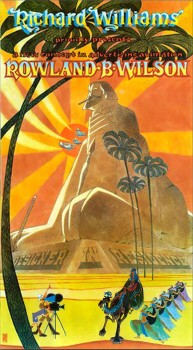 Creative Talent Network has a nice page up for him here. They also offer an extensive resume here.
Creative Talent Network has a nice page up for him here. They also offer an extensive resume here.
Mark Kennedy offers a number of Wilson’s handouts on color, light and shadow and composition.
AWN had a fine memorial piece to Wilson written by John Culhane. here
I’d like to post here some of Myrna Oliver‘s obit from the LA Times 7/11/05:
- Born Aug. 3, 1930, in Dallas, Rowland Bragg Wilson grew up drawing Disney characters at the kitchen table. He received a bachelor’s of fine arts from the University of Texas at Austin and then moved to New York City for graduate work at Columbia University.
To support himself, he began creating gag cartoons for the Saturday Evening Post, Collier’s, Look and True magazines. He was drafted into the Army, serving from 1954 to 1956, where he used his artistic talents to draw classified charts.
In 1957, Wilson joined the Young & Rubicam Inc. _____a poster done for Dick Williams
advertising agency where he spent seven years as
an art director, doing conceptual drawings for print ads.
At the same time he stepped up his freelancing of cartoons to magazines and became a regular with Esquire in 1958. In the late ’50s and early ’60s he also had cartoons published in the New Yorker.
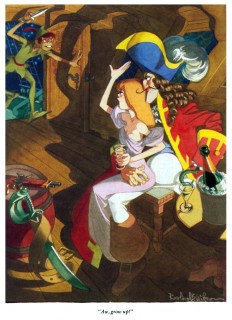 He established himself as a freelance advertising artist in 1964 but never gave up cartooning, which he described as “picture writing.†Forced by his lucrative advertising contracts to limit cartoon work to a single magazine, he focused on Playboy after Esquire abandoned its full-page cartoons.
He established himself as a freelance advertising artist in 1964 but never gave up cartooning, which he described as “picture writing.†Forced by his lucrative advertising contracts to limit cartoon work to a single magazine, he focused on Playboy after Esquire abandoned its full-page cartoons.
In 1967, he also drew “Noon,†a short-lived comic strip for the New York News-Chicago Tribune Syndicate (Tribune Corp. now owns the Los Angeles Times).
As Wilson once described the strip, “The name of the main character was Noon Ringle, an unemployed cowboy in a dying small Texas town in sort of modern times.â€
Wilson illustrated two children’s books in the early ’70s, “Tubby and the Lantern†and “Tubby and the Poo-Bah.â€
It was advertising that moved him into ________a Rowland Wilson cartoon for Playboy
animation, and from 1973 to 1975 he worked in
London as a designer for the primarily commercial animation studio of Richard Williams. On his return to New York, he joined Phil Kimmelman and Associates, which concentrated mainly on advertising work.
In his cartoons, advertisements, designs for animated characters and illustrations, Wilson was known for three-dimensional drawings filled with historical detail.
“Ideas are easy to come by,†he often said, according to his daughter. “It is the drawing that takes a long time.â€
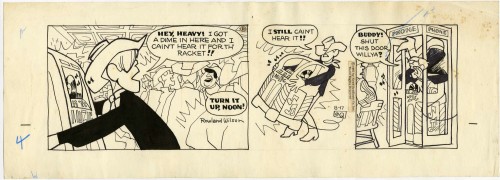
A sample of the strip “Noon”
As an animator, Wilson won a daytime Emmy Award in 1980 for his work on ABC’s “HELP! Dr. Henry’s Emergency Lessons for People†and worked on educational animation, including the television series “Schoolhouse Rock.â€
In 1975, Wilson won awards at the Venice and Irish Animation festivals, and his animated commercial film “The Trans-Siberian Express†won first prize at the third International Animation Festival in New York. He also won a Clio.
He worked for Walt Disney Feature Animation as a visual developer and served as a layout designer for “The Little Mermaid†in 1989. He also contributed to “The Hunchback of Notre Dame†and “Tarzan†among others.
But Wilson’s greatest legacy may be on the printed page. His cartoons, widely published in magazines, were reprised in several anthologies, beginning with “Don’t Fire Until You See the Whites of Their Eyes,†a collection of his Esquire work published in 1963. He earned Playboy’s Cartoonist of the Year award in 1982 and his work was included in the 2004 anthology “Playboy – 50 Years: The Cartoons.â€
For all Wilson’s love of animation, “It was sketches for a new Playboy cartoon that were on his drawing board when he died,†said his daughter Megan Wilson.
Wilson also worked extensively in advertising and was particularly lauded for his 40 or so humorous works for New England Mutual Life Insurance Co. Each cartoon-type ad depicted a person in dire straits – such as an executive with his back to a high-rise office window as a wrecking ball swings toward him, proclaiming, “My life insurance company? New England Life, of course. Why?â€
Wilson’s first marriage to Elaine Libman ended in divorce. He is survived by his second wife, artist Suzanne Lemieux Wilson; four daughters, who are all commercial artists, Amanda Wilson of Piermont, N.Y., Reed Wilson of London, Kendra Wilson of Leicestershire, England, and Megan of New York City; and three grandchildren.
The storyboard by Rowland Wilson for “Lucky 7″ Schoolhouse Rock.
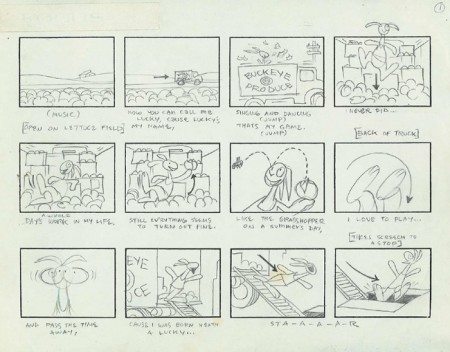
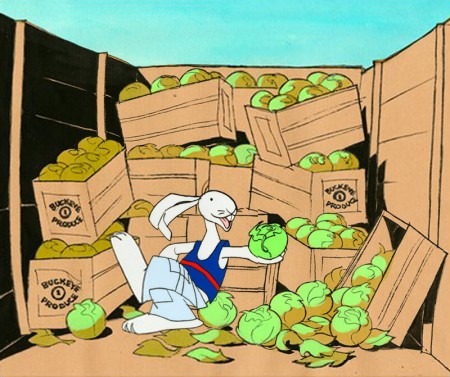
Art available on Amazon from Creative Talent Network.
.
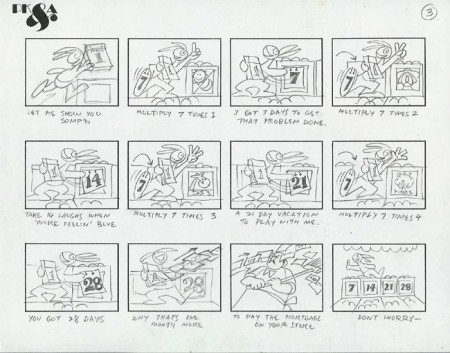
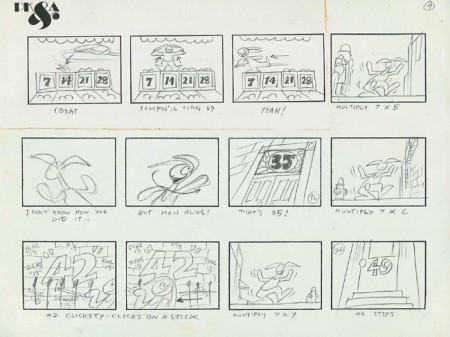

on 02 Dec 2008 at 9:48 am 1.bill said …
Ask and ye shall receive!
Thanks Michael!
on 02 Dec 2008 at 1:02 pm 2.scott said …
Hmm, is this in response to to recent CTN page for RBW originals? I worked with Rowland at Bluth and Disney, so only knew him in his later years… with the moustache and cravat. Talked alot to him about his past stuff, but I never knew he had a beard! Wow, he wore 70s clothes too!
Thanks for this bit of extra Rowland info.
on 02 Dec 2008 at 2:32 pm 3.Mark Mayerson said …
I had the pleasure of meeting Rowland just once at his home, courtesy of Greg Duffell and Jeff Short who had worked with him at the Dick Williams studio. He was a very gracious host. It goes without saying that I was a huge admirer of his work.
on 02 Dec 2008 at 2:43 pm 4.Tom Sito said …
Thanks for all that data, Mike. I knew Rowland and stay in touch with Susan. Rowland was a well spoken, but modest man who loved making art.
His color development work did a lot to effect the final look of Disney’s The Little Mermaid. But his ideas for the mer-people went a lot further than the final. He figured because they almost never went to the surface, he made them with much paler, light blue skin and turquoise eyes. Some had fish-combs instead of hair. It was quite striking. But the studio heads instead wanted those Malibu tans on them. You can’t argue with success, but it was an intriguing look.
on 02 Dec 2008 at 3:02 pm 5.Michael said …
Scott, the CTN email reminded me that I hadn’t written about Rowland and since I was asked about my experience with Schoolhouse Rock, I responded. It was nice to have the reminder from CTN.
on 03 Dec 2008 at 12:39 am 6.Will Finn said …
Rowlands office was right next door to mine during development on Disney’s HUNCHBACK. I was in awe but he was as affable and welcoming as could be. I asked about his influences and one of the people he turned me on to was Vernon Grant, who i had never heard of before. The minute you see his stuff you see a bit of Rowland in it… He also loved Germanic designers and several times mentioned being related to Charles Bragg although so distantly he had never met him.
Like me, Rowland was a huge fan of the radio comedians Bob & Ray and we used to trade bits often. When he retired i missed him and although he extended an open invitation, i never got around to visiting him at home. He signed a copy of his brilliant Playboy SNOW WHITE gag (“…that part of my life is over!”) which i still prize. a wonderful artist and a kind and distinguished gentleman.
on 03 Dec 2008 at 1:07 am 7.Tina Price said …
Michael – This is a GREAT post!! And thanks for the link back to CTN. Some of Rowland’s original artwork and prints are being offered for sale from his wife Suzanne Wilson via CTN at http://astore.amazon.com/rowland.wilson-20 including that Richard Williams poster and full color archival prints of his handouts that look as if they were the originals.
Thanks so much for all you do, this is an absolutely awesome tribute of information and I have passed your article/post onto Suzanne as well.
Tina Price
on 05 Dec 2008 at 5:51 pm 8.Matt Jones said …
Excellent write up on Wilson-educational
on 21 Dec 2008 at 2:19 am 9.Tim Rauch said …
Finally got around to reading this. I’ve said it many times before but let me say it again: thanks for everything you do to make some of the more obscure names in American animation known. It is good and important work and I hope it is as rich and rewarding an experience for you to share these things with us as it has been for me to read them.
on 11 Mar 2012 at 11:31 pm 10.Roland Vela said …
I think Rowland Wilson and I were roommates one or two semester in 1948 or 49 at Little Campus Dormitory, The University of Texas, Austin, Texas.
I was a science major and he drew several sketches for me of things I had to draw for Laboratory Reports in several courses. Unfortunately, I lost them!
I kept up with his cartoons in New Yorker, etc until they stopped coming out. Later they appeared again under the signature Gahan Wilson.
Am I right in sll this or has it all gotten away from me during the last 60 years?
on 12 Mar 2012 at 1:05 am 11.Michael said …
Gahan Wilson is a very different cartoonist. You should figure out which of the two artists you knew.
on 07 May 2015 at 9:22 pm 12.Blair Watrs said …
for the best divorce attorney contact deborah zukin